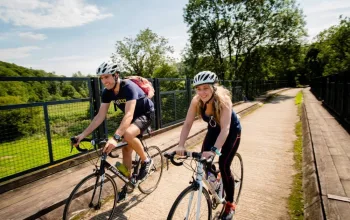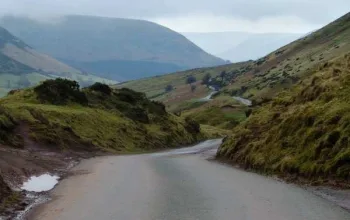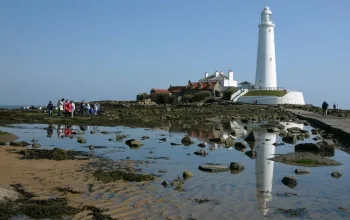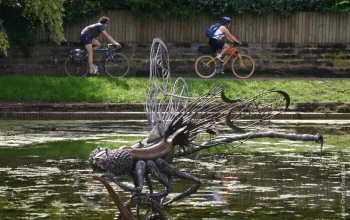Why are ruins so captivating? For most of human history people saw ruins as nothing more than junk and mess. They were broken down and their stones used in other buildings, or repurposed as pigsties and cow byres. It was not until the 17th century that the first antiquarians took an interest in what ruins might tell us about the past. But a ruin also makes us think about the future. They remind us that nothing is forever, that decay is irresistible. It's a melancholic feeling to be standing on the tumbledown remains of a once-magnificent castle, abbey or stately home, imagining what once went on there. Likewise, to clamber into an old farmhouse, roof long since gone, and find a tree growing where the kitchen table once stood.
How did it come to this? What if the people who once lived there could see it now? No wonder the Romantic movement of the 18th century saw the ruin rise from eyesore to tourist destination and status symbol (it was quite common for the landed gentry to enhance their landscape gardens with fake ruins and grottoes). With war and revolution rendering the Greek and Roman ruins of the Grand Tour off-limits to the leisured elites, they started going instead to the lower Wye valley, with its swirling waters, rocky outcrops, steep-sided gorges and picturesque, ivy-clad ruins.
This ride follows a trail of ruins, starting at Chepstow, where the Norman cliff-top castle, begun barely a year after the Battle of Hastings, guards a strategic crossing point of the River Wye. Cyclists in Chepstow have long been campaigning for the old railway line up the Wye to be converted into a cycling and walking path, and this would make the journey up to Tintern Abbey a joy. But until that becomes a reality, the only option is on the A466 past the racecourse to St Arvans. It's a fast main road so not a particularly pleasant ride but fortunately there is a shared-use cycling and walking path beside it.
From St Arvans, the route follows the Devaulden Road (National Cycle Route 31) into Chepstow Park Wood, 3,300 acres of mixed woodland and once the hunting ground of Roger Bigod, an early medieval lord of Chepstow Castle. After a right turn towards the Cot, there's a long, winding descent down the steep-sided Angiddy valley, passing some of the ruins of ironworks that made this valley Wales's largest industrial complex in the 1600s. Edward Davies, the Chepstow poet, writing in 1804 spoke of where "black forges smoke, and noisy hammers beat... melting furnaces like Etna roar, and force the latent iron from the ore". It takes some imagination to picture it now.
Tintern Abbey, only the second Cistercian abbey established in the British Isles, dominated the local economy for 400 years, surviving violent power struggles between the monarch and the Marcher lords, the Welsh uprising of Owain Glyndwˆ r and even the Black Death. But Henry VIII's dissolution of the monasteries brought a swift end to monastic life in the valley. Iron masters soon took the place of monks, and Tintern's wireworks were up and running by the 1560s, making the lower Wye one of the incubators of Britain's industrial revolution.
The climb up from Tintern to Trellech featured in the national road race championship of 2014. More than a century earlier it was the scene of a spectacular bike crash involving George Bernard Shaw and Bertrand Russell. The pair were staying with socialists and writers Beatrice and Sidney Webb at the Argoed, a country house overlooking the Wye at Penallt, and it appears from the reports that Russell, aged 23 at the time, absentmindedly stopped to look at a signpost and was rear-ended by Shaw, who flew into the air and came to a halt five yards further down the hill. Shaw was able to ride home and in reports at the time the bearded man of letters "attributes his escape from serious consequences to the splendid quality of bone and muscle produced by vegetarian diet and Jaeger clothing".
Now a quiet village with a church, a pub and a village green, it's almost impossible to imagine that Trellech was once the largest settlement in medieval Wales, but that is exactly what the 'Lost City of Trellech' archeologists believe they are slowly uncovering. Continuing on through the villages and hamlets that dot the ridge between the Wye and the Usk rivers, the ride reaches Earlswood. From here there is a fabulous view of the River Severn, including the 'new' bridge opened in 1996 and beyond it the industrial sprawl of Avonmouth. One day all that will be ruins too, just like the village of Runston, the last ruin on this ride. All that remains of the medieval village is the chapel, roofless but with its Norman chancel arch perfectly intact. Tintern it's not, but it's nevertheless a moving place to stop and contemplate the nature of existence before the final downhill run to Chepstow.





















